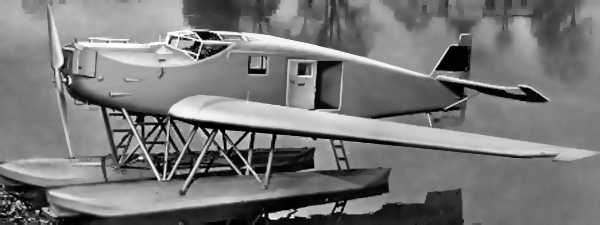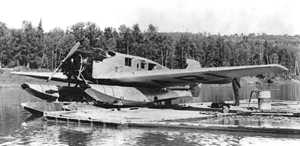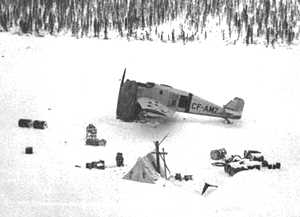Junkers W33/W34

Specifications (Canadian W34)
|
|---|
| Wing Span: | 17.8 m (58 ft 3 1/2 in) | Cruising Speed: | 222 km/h (138 mi) |
|---|
| Length: | 10.3 m (33 ft 8 3/8 in) | Max Speed: | 264 km/h (164 mph) |
|---|
| Height: | 3.19 m (10 ft 6 in) | Rate of Climb: | 2,000 m (6,560 ft)/9 min |
|---|
| Weight, Empty: | 1,655 kg (3,649 lb) | Service Ceiling: | 6,900 m (22,640 ft) |
|---|
| Weight, Gross: | 3,200 kg (7,055 lb) | Range: | 789 km (490 mi) |
|---|
Historical Data:
The Junkers W33 was a direct modification of the Junkers F13 for cargo operations. The fuselage was lower than that of the F13 as there was no passenger compartment and the initial series did not have any windows in the cargo compartment. For combined cargo/passenger operations these windows were again introduced on later versions of the W33. The cargo loading could be performed through a side door or through a door in the cabin roof. On June 17th 1926 Zimmermann performed the first flight of the Junkers W33 (c/n 794). The prototype was a seaplane version and the first flight was performed on river Elbe at Leopoldshafen near Dessau.
 The first W34 was first flown just a few weeks after the W33 on July 7th 1926 by Zimmermann. Both prototypes appeared nearly identical except for the different engines. Instead of the Junkers L5 engine of the W33, the W34 was equipped with a 353kW Gnome et Rhone Jupiter VI engine. While future developements of the W33 kept the Junkers engines, the W34 was offered with a wide range of different engines, which also influenced the outside appearance and dimensions of the W34. Also the cabin roof was a little bit higher as on the W33, making the W34 more capable as a combined cargo and passenger airliner. Finally the early serial production W34 also show differences at the tail unit, which was larger than that of the W33.
The first W34 was first flown just a few weeks after the W33 on July 7th 1926 by Zimmermann. Both prototypes appeared nearly identical except for the different engines. Instead of the Junkers L5 engine of the W33, the W34 was equipped with a 353kW Gnome et Rhone Jupiter VI engine. While future developements of the W33 kept the Junkers engines, the W34 was offered with a wide range of different engines, which also influenced the outside appearance and dimensions of the W34. Also the cabin roof was a little bit higher as on the W33, making the W34 more capable as a combined cargo and passenger airliner. Finally the early serial production W34 also show differences at the tail unit, which was larger than that of the W33.
While the W33/W34 could be built in Germany after the ban over Germany's aviation industry was lowered in 1926, Junkers still was forced to convert his aircraft for military purposes outside of Germany. A military derivate was built from the W34 at A.B. Flygindustri at Limhamn in Sweden under the designation K43. This K43 mounted a machine gun tower at the rear part of the cabin. It could be used as a transport aircraft, but also as a light bomber aircraft. At least 18 militarized K43 left Limhamn for Finland, Argentina, Portugal, Bolivia and Chile. Additional 21 W33/W34 should have been built at Limhamn. Some of these were ambulance aircraft and transport aircraft for military purposes. One W33g was sold to the Swedish Air Force in 1933 and designated as Trp 2. It was used until 1935 as an ambulance aircraft in Sweden. Two further W34h were used by the Swedish Air Force as Trp 2A between 1933 and 1945 for the same purpose.
 A large number of W33 aircraft were ordered by Russia. The parts for these aircraft were built at Dessau and were shipped Irkutsk and to the Dobrolet repair station at Moscow, where the aircraft were finally assembled from 1928. These W33 were used in Russia as PS-3. They were used until 1941 for postal and cargo flights mainly in Siberia. In March 1933 the Dobroljot repair station at Irkutsk started the construction of their own W33 without the support of Junkers. Until 1935 a total of at least nine of those so-called PS-4 were built at Irkutsk and Moscow. These PS-4 showed several differences to the original W33. Like the initial W33 of 1926 the PS-4 had no windows in the cargo compartement as it was used only as a freighter aircraft in Siberia.
A large number of W33 aircraft were ordered by Russia. The parts for these aircraft were built at Dessau and were shipped Irkutsk and to the Dobrolet repair station at Moscow, where the aircraft were finally assembled from 1928. These W33 were used in Russia as PS-3. They were used until 1941 for postal and cargo flights mainly in Siberia. In March 1933 the Dobroljot repair station at Irkutsk started the construction of their own W33 without the support of Junkers. Until 1935 a total of at least nine of those so-called PS-4 were built at Irkutsk and Moscow. These PS-4 showed several differences to the original W33. Like the initial W33 of 1926 the PS-4 had no windows in the cargo compartement as it was used only as a freighter aircraft in Siberia.
W33/W34s were used for a wide range of purposes, e.g. as transport, reconnaissance or bomber aircraft, but also as ambulance and pest control aircraft. They were used by operators on all five continents. The Dessau W33 production was stopped during 1932. At Limhamn some K43s were still built in 1933, when production was stopped there. The last W33s were built in Russia during late 1934 / early 1935. In 1933 Luftwaffe again ordered a larger number of W34s, which were delivered until 1935. These aircraft were later used during the Spanish Civil War by Legion Condor. After the end of WWII most W33/W34 were retired. The last W34 was a Canadian W34, which went out of service in 1961.
Record flights of the W33:
1927 World Record Flights of the W33
On March, 16th 1927 a continous flight world record was achieved by Schnabele with a W33L. With 500kg payload he flew 15hrs and 57 minutes.
Three days later Junkers pilot Loose achieved the same record with a W33 seaplane. He flew 14hrs and 8 minutes with 500kg payload over 1702km, which means also the world record for distance.
On March 21th, 1927 Loose and Schnabele together achieved a further record with the landplane W33L with 22hrs and 11 minutes with 500 kg payload. During this flight they achieved also a distance record with 2735km.
On July 5th, 1927 Junkers pilots Zimmermann and Risztics achieved another world record for continous flight with a W33L with 65hrs and 25 minutes.
Risztics and Edzard achieved the next W33 world record on August, 3rd 1927 with a W33. They flew for a distance of 4660 km a new distance world record. They needed 52hrs and 22 minutes for that flight
12.04.1928 First East-West Atlantic Crossing
The W33 was the first aircraft to cross the Atlantic Ocean from East to West.
On April 12th, 1928 Hermann Koehl, Guenther von Huenefeld and Major Fitzmaurice started with D-1197 Bremen (c/n 2504) from the Irish Baldonell to New York. After 36 hours they landed at Greenly Island on Labrador.
The original "Bremen" today is owned by the Henry Ford Museum in Detroit and is currently under display at Bremen Airport in Germany.
The 1928 transatlantic crossing was already Koehl's second approach. On August, 14th 1927 Koehl, Loose and Huenefeld already took off from Germany with "Bremen", together with Risztics, Edzard and Knickerbocker onboard the W33 "Europa" for the first approach. But this approach failed due to bad weather and engine troubles of "Europa".
Sept. 1928 East Asia Flight of Hunefeld
During September 1928 Hunefeld and Lindner used another W33 (c/n 2506), which was also named "Europa", for a flight to East Asia. They needed 12 days and 90 flying hours for the 14250 km route to Tokyo with 10 refuelling stops.
July 1929 First Rocket supported Take off with a W33
In July 1929 Zimmermann performed the first take off with the support of rockets mounted on a W33. Four Eisfeld rockets were used during a few seconds of the take off run on the river Elbe near Dessau.
02.11.1930 First Inflight Fueling with a W33
Luft Hansa and DVL tested inflight fueling of aircraft in 1930. A DVL Fokker F II was the tanker aircraft, while the W33 was fuelled through a 20 meter long connection.
Record flights of the W34:
11.05.1927 Speed Record Flight
On May, 11th 1927 Georg Jueterbock reached a new world speed record with a W34. With 500kg payload he reached a speed of 194,2 km/h over 500km. The flight was continued over 1000km with 181,44 km/h.
14.09.1928 Altitude Record
On September, 14th 1929 again Jueterbock reached a new altitude record with a W34. With 500kg payload he reached 9190 meters. Later on with 1000 kg he reached 7907 meters. In the same year Franz Kneer reached an altitude of 6389 meters with 1000kg payload which was the new altitude record for seaplanes.
26.05.1929 World Altitude Record
On May, 26th 1929 Willy Neuenhofen reached a new world altitude record with a W34. In 45 minutes Neuenhofen climbed up to 12739 meters. The W34be (c/n 2600) was equipped with a new larger wing and a Bristol Jupiter VII engine and a minimum of equipment on board.
25.07.1929 Rocket Take off with W34
On July, 25th 1929 first trials with take off supporting rockets were made with a W34. The aircraft was flown by Wilhelm Zimmermann, who started the take off run with the conventional engine power. Then several ignitions of the Eisfeld-Pulver-rockets were made, which lifted the aircraft up into the air. The trials were performed with a W34 seaplane with floaters at Leopoldshafen on the river Elbe near Dessau. It was the first time to use rocket power for the take off support.

 The first W34 was first flown just a few weeks after the W33 on July 7th 1926 by Zimmermann. Both prototypes appeared nearly identical except for the different engines. Instead of the Junkers L5 engine of the W33, the W34 was equipped with a 353kW Gnome et Rhone Jupiter VI engine. While future developements of the W33 kept the Junkers engines, the W34 was offered with a wide range of different engines, which also influenced the outside appearance and dimensions of the W34. Also the cabin roof was a little bit higher as on the W33, making the W34 more capable as a combined cargo and passenger airliner. Finally the early serial production W34 also show differences at the tail unit, which was larger than that of the W33.
The first W34 was first flown just a few weeks after the W33 on July 7th 1926 by Zimmermann. Both prototypes appeared nearly identical except for the different engines. Instead of the Junkers L5 engine of the W33, the W34 was equipped with a 353kW Gnome et Rhone Jupiter VI engine. While future developements of the W33 kept the Junkers engines, the W34 was offered with a wide range of different engines, which also influenced the outside appearance and dimensions of the W34. Also the cabin roof was a little bit higher as on the W33, making the W34 more capable as a combined cargo and passenger airliner. Finally the early serial production W34 also show differences at the tail unit, which was larger than that of the W33.
 A large number of W33 aircraft were ordered by Russia. The parts for these aircraft were built at Dessau and were shipped Irkutsk and to the Dobrolet repair station at Moscow, where the aircraft were finally assembled from 1928. These W33 were used in Russia as PS-3. They were used until 1941 for postal and cargo flights mainly in Siberia. In March 1933 the Dobroljot repair station at Irkutsk started the construction of their own W33 without the support of Junkers. Until 1935 a total of at least nine of those so-called PS-4 were built at Irkutsk and Moscow. These PS-4 showed several differences to the original W33. Like the initial W33 of 1926 the PS-4 had no windows in the cargo compartement as it was used only as a freighter aircraft in Siberia.
A large number of W33 aircraft were ordered by Russia. The parts for these aircraft were built at Dessau and were shipped Irkutsk and to the Dobrolet repair station at Moscow, where the aircraft were finally assembled from 1928. These W33 were used in Russia as PS-3. They were used until 1941 for postal and cargo flights mainly in Siberia. In March 1933 the Dobroljot repair station at Irkutsk started the construction of their own W33 without the support of Junkers. Until 1935 a total of at least nine of those so-called PS-4 were built at Irkutsk and Moscow. These PS-4 showed several differences to the original W33. Like the initial W33 of 1926 the PS-4 had no windows in the cargo compartement as it was used only as a freighter aircraft in Siberia.